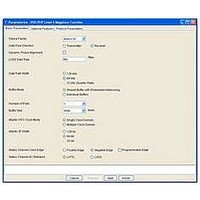IP-POSPHY4 Altera, IP-POSPHY4 Datasheet - Page 25

IP-POSPHY4
Manufacturer Part Number
IP-POSPHY4
Description
IP CORE - POS-PHY Level 4 SPI 4.2 Interface
Manufacturer
Altera
Type
MegaCorer
Datasheet
1.IP-POSPHY4.pdf
(144 pages)
Specifications of IP-POSPHY4
Software Application
IP CORE, Interface And Protocols, COMMUNICATION
Supported Families
Arria GX, Cyclone, HardCopy, Stratix
Core Architecture
FPGA
Core Sub-architecture
Arria, Cyclone, Stratix
Rohs Compliant
NA
Function
POS-PHY Level 4 Interface, Link-Layer/PHY Layer
License
Initial License
Lead Free Status / RoHS Status
na
Lead Free Status / RoHS Status
na
- Current page: 25 of 144
- Download datasheet (3Mb)
Chapter 3: Parameter Settings
Basic Parameters
December 2010 Altera Corporation
LVDS Data Rate
PLL Input Frequency
Data Path Width
Buffer Mode
f
1
1
For a transmitter, the LVDS data rate specifies the data rate out of the FPGA, on each
LVDS pair.
IP Toolbench uses this parameter to instantiate and configure the ALTLVDS
megafunction that includes the fast PLL. For example, to configure a transmitter with
a data rate of 700 Mbps on the tdat line, enter 700 in the LVDS Data Rate field of IP
Toolbench. This rate corresponds to a 350 MHz DDR clock on tdclk.
For a receiver, the LVDS data rate specifies the data rate into the FPGA, on each LVDS
pair, and sets the phase-locked loop (PLL) clock rate.
IP Toolbench uses the LVDS data rate to instantiate and parameterize the ALTLVDS
megafunction that includes the fast PLL. For example, for a receiver with a data rate
of 700 Mbps on each rdat line, enter 700 in LVDS data rate. This value corresponds to
a 350 MHz double-data rate (DDR) clock on rdclk.
For a transmitter only, you can enter the PLL input frequency. To enter the PLL
frequency, you must click Import PLL Frequency, to open the ALTLVDS wizard and
view the available input PLL frequencies.
When you change the data path width, the PLL input frequency changes.
Do not type the PLL frequency into the box.
The Data path width affects two important aspects of the MegaCore function: size
and performance. The MegaCore function offers the following options:
■
■
■
For approximate resource usage and performance of example POS-PHY Level 4
variations, refer to
The POS-PHY Level 4 MegaCore function supports the following two buffer modes:
■
■
With Shared buffer with embedded addressing, all ports share a single Atlantic
buffer with an 8-bit address field that supports up to 256 ports. The data is read from
the Atlantic buffer in the same order as it is received. The shared buffer with
embedded addressing mode is smaller than the individual buffers mode, and allows
you to develop your own buffering and status generation implementation.
128 bits running at a frequency of 1/8 the LVDS data rate
64 bits running at 1/4 the LVDS data rate
32 bits (quarter rate) running at 1/2 the LVDS data rate (for non-standard
applications at a maximum of 250 Mbps)
Shared buffer with embedded addressing
Individual buffers
“Performance and Resource Utilization” on page
POS-PHY Level 4 MegaCore Function User Guide
1–6.
3–3
Related parts for IP-POSPHY4
Image
Part Number
Description
Manufacturer
Datasheet
Request
R

Part Number:
Description:
IP CORE Renewal Of IP-POSPHY4
Manufacturer:
Altera
Datasheet:

Part Number:
Description:
IP Thermal Transfer Printer With Peel/Present Option
Manufacturer:
BRADY

Part Number:
Description:
CYCLONE II STARTER KIT EP2C20N
Manufacturer:
Altera
Datasheet:

Part Number:
Description:
CPLD, EP610 Family, ECMOS Process, 300 Gates, 16 Macro Cells, 16 Reg., 16 User I/Os, 5V Supply, 35 Speed Grade, 24DIP
Manufacturer:
Altera Corporation
Datasheet:

Part Number:
Description:
CPLD, EP610 Family, ECMOS Process, 300 Gates, 16 Macro Cells, 16 Reg., 16 User I/Os, 5V Supply, 15 Speed Grade, 24DIP
Manufacturer:
Altera Corporation
Datasheet:

Part Number:
Description:
Manufacturer:
Altera Corporation
Datasheet:

Part Number:
Description:
CPLD, EP610 Family, ECMOS Process, 300 Gates, 16 Macro Cells, 16 Reg., 16 User I/Os, 5V Supply, 30 Speed Grade, 24DIP
Manufacturer:
Altera Corporation
Datasheet:

Part Number:
Description:
High-performance, low-power erasable programmable logic devices with 8 macrocells, 10ns
Manufacturer:
Altera Corporation
Datasheet:

Part Number:
Description:
High-performance, low-power erasable programmable logic devices with 8 macrocells, 7ns
Manufacturer:
Altera Corporation
Datasheet:

Part Number:
Description:
Classic EPLD
Manufacturer:
Altera Corporation
Datasheet:

Part Number:
Description:
High-performance, low-power erasable programmable logic devices with 8 macrocells, 10ns
Manufacturer:
Altera Corporation
Datasheet:

Part Number:
Description:
Manufacturer:
Altera Corporation
Datasheet:

Part Number:
Description:
Manufacturer:
Altera Corporation
Datasheet:











